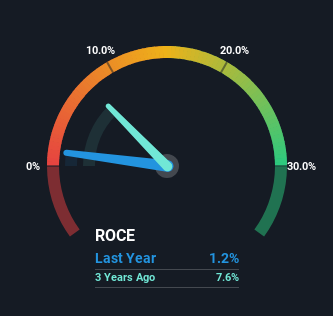- United States
- /
- Food
- /
- NasdaqCM:FAMI
Returns On Capital At Farmmi (NASDAQ:FAMI) Paint A Concerning Picture

If you're not sure where to start when looking for the next multi-bagger, there are a few key trends you should keep an eye out for. Firstly, we'll want to see a proven return on capital employed (ROCE) that is increasing, and secondly, an expanding base of capital employed. If you see this, it typically means it's a company with a great business model and plenty of profitable reinvestment opportunities. Having said that, from a first glance at Farmmi (NASDAQ:FAMI) we aren't jumping out of our chairs at how returns are trending, but let's have a deeper look.
Return On Capital Employed (ROCE): What Is It?
Just to clarify if you're unsure, ROCE is a metric for evaluating how much pre-tax income (in percentage terms) a company earns on the capital invested in its business. The formula for this calculation on Farmmi is:
Return on Capital Employed = Earnings Before Interest and Tax (EBIT) ÷ (Total Assets - Current Liabilities)
0.012 = US$2.0m ÷ (US$175m - US$11m) (Based on the trailing twelve months to September 2023).
Thus, Farmmi has an ROCE of 1.2%. Ultimately, that's a low return and it under-performs the Food industry average of 11%.
Check out our latest analysis for Farmmi

While the past is not representative of the future, it can be helpful to know how a company has performed historically, which is why we have this chart above. If you'd like to look at how Farmmi has performed in the past in other metrics, you can view this free graph of Farmmi's past earnings, revenue and cash flow.
So How Is Farmmi's ROCE Trending?
On the surface, the trend of ROCE at Farmmi doesn't inspire confidence. To be more specific, ROCE has fallen from 16% over the last five years. Although, given both revenue and the amount of assets employed in the business have increased, it could suggest the company is investing in growth, and the extra capital has led to a short-term reduction in ROCE. If these investments prove successful, this can bode very well for long term stock performance.
In Conclusion...
Even though returns on capital have fallen in the short term, we find it promising that revenue and capital employed have both increased for Farmmi. But since the stock has dived 100% in the last five years, there could be other drivers that are influencing the business' outlook. Regardless, reinvestment can pay off in the long run, so we think astute investors may want to look further into this stock.
On a separate note, we've found 3 warning signs for Farmmi you'll probably want to know about.
While Farmmi isn't earning the highest return, check out this free list of companies that are earning high returns on equity with solid balance sheets.
New: AI Stock Screener & Alerts
Our new AI Stock Screener scans the market every day to uncover opportunities.
• Dividend Powerhouses (3%+ Yield)
• Undervalued Small Caps with Insider Buying
• High growth Tech and AI Companies
Or build your own from over 50 metrics.
Have feedback on this article? Concerned about the content? Get in touch with us directly. Alternatively, email editorial-team (at) simplywallst.com.
This article by Simply Wall St is general in nature. We provide commentary based on historical data and analyst forecasts only using an unbiased methodology and our articles are not intended to be financial advice. It does not constitute a recommendation to buy or sell any stock, and does not take account of your objectives, or your financial situation. We aim to bring you long-term focused analysis driven by fundamental data. Note that our analysis may not factor in the latest price-sensitive company announcements or qualitative material. Simply Wall St has no position in any stocks mentioned.
About NasdaqCM:FAMI
Farmmi
Through its subsidiaries, engages in processing and sale of agricultural products in China, the United States, Japan, Canada, Europe, Korea, and the Middle East.
Adequate balance sheet and slightly overvalued.
Market Insights
Community Narratives



